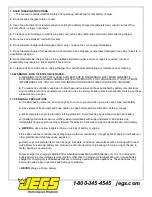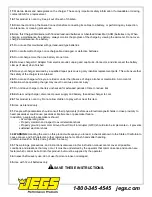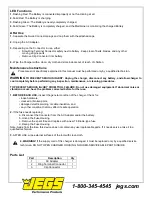
1. SAVE THESE INSTRUCTIONS
– This manual contains important safety and operating instructions for this battery charger.
2.
Do not expose charger to rain or snow.
3.
Use of an attachment not recommended or sold by the battery charger manufacturer may result in a risk of fire,
electric shock, or injury to persons.
4.
To reduce risk of damage to electric plug and cord, pull by plug rather than cord when disconnecting charger.
5.
Do not use an extension cord with this item.
6.
Do not operate charger with damaged cord or plug
– replace the cord or plug immediately.
7.
Do not operate charger if it has received a sharp blow, been dropped, or otherwise damaged in any way; take it to a
qualified serviceman.
8.
Do not disassemble charger; take it to a qualified serviceman when service or repair is required. Incorrect
reassembly may result in a risk of electric shock or fire.
9.
To reduce risk of electric shock, unplug charger from outlet before attempting any maintenance or cleaning.
10.
WARNING
– RISK OF EXPLOSIVE GASES.
a.
WORKING IN VICINITY OF A LEAD-ACID BATTERY IS DANGEROUS. BATTERIES GENERATE
EXPLOSIVE GASES DURING NORMAL BATTERY OPERATION. FOR THIS REASON, IT IS OF UTMOST
IMPORTANCE THAT YOU FOLLOW THE INSTRUCTIONS EACH TIME YOU USE THE CHARGER.
b.
To reduce risk of battery explosion, follow these instructions and those published by battery manufacturer
and manufacturer of any equipment you intend to use in vicinity of battery. Review cautionary marking on these
products and on engine.
11.
PERSONAL PRECAUTIONS
a.
Consider having someone close enough by to come to your aid when you work near a lead-acid battery.
b.
Have plenty of fresh water and soap nearby in case battery acid contacts skin, clothing, or eyes.
c.
Wear complete eye protection and clothing protection. Avoid touching eyes while working near battery.
d.
If battery acid contacts skin or clothing, wash immediately with soap and water. If acid enters eye,
immediately flood eye with running cold water for at least 10 minutes and get medical attention immediately.
e.
NEVER
smoke or allow a spark or flame in vicinity of battery or engine.
f.
Be extra cautious to reduce risk of dropping a metal tool onto battery. It might spark or short-circuit battery or
other electrical part that may cause explosion.
g.
Remove personal metal items such as rings, bracelets, necklaces, and watches when working with a lead-
acid battery. A lead-acid battery can produce a short-circuit current high enough to weld a ring or the like to
metal, causing a severe burn.
h.
Use charger for charging LEAD-ACID or Absorbed Glass Mat (AGM) batteries only. It is not intended to
supply power to a low voltage electrical system other than in a starter-motor application.
Do not use battery
charger for charging dry-cell batteries that are commonly used with home appliances. These batteries may
burst and cause injury to persons and damage to property.
i. NEVER
charge a frozen battery.
1-800-345-4545 jegs.com
























